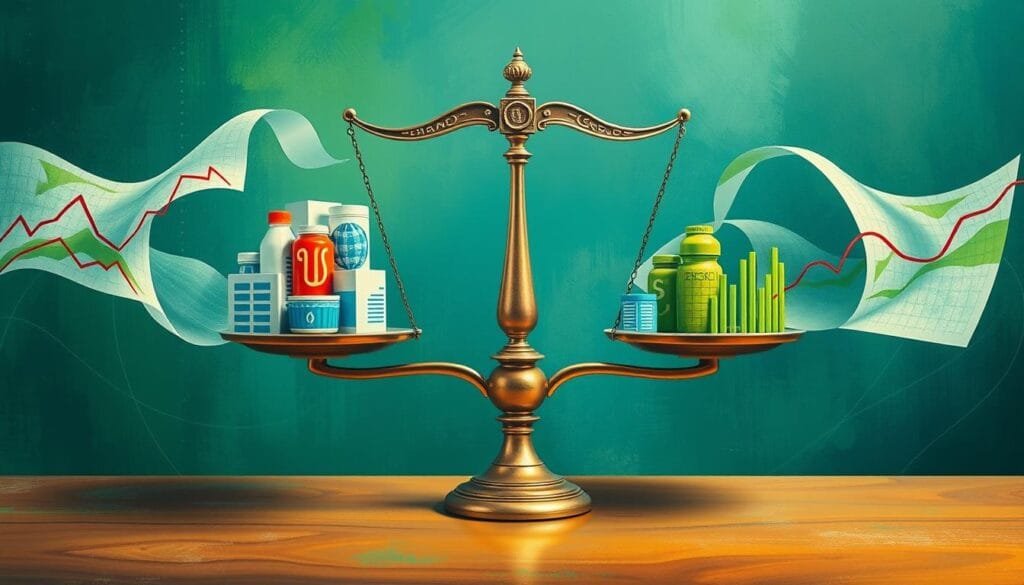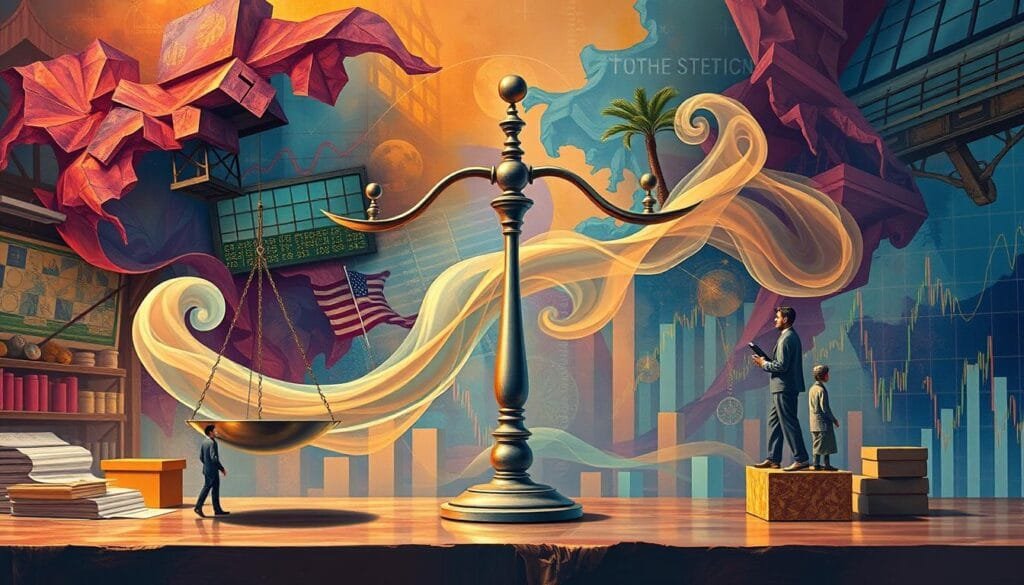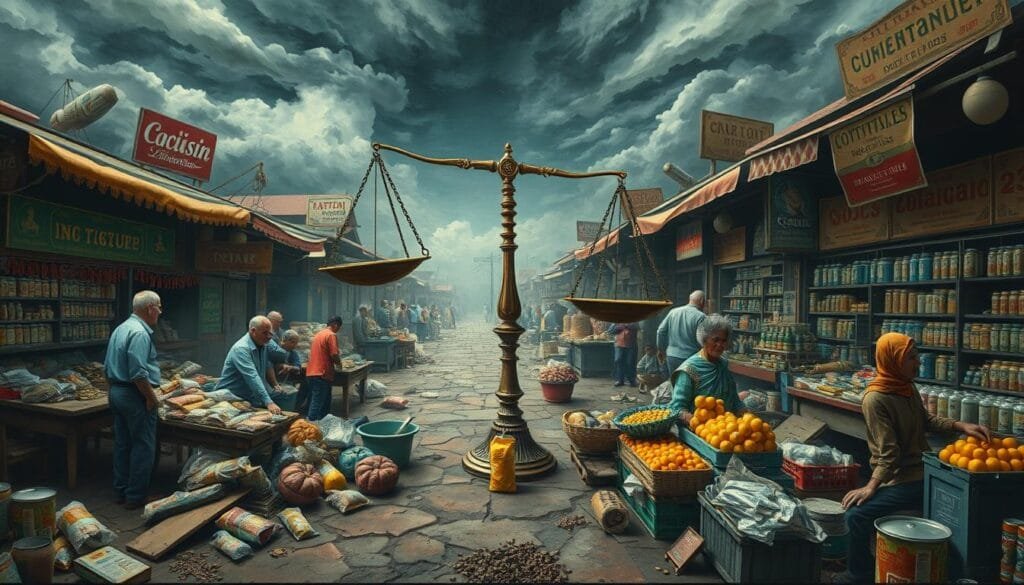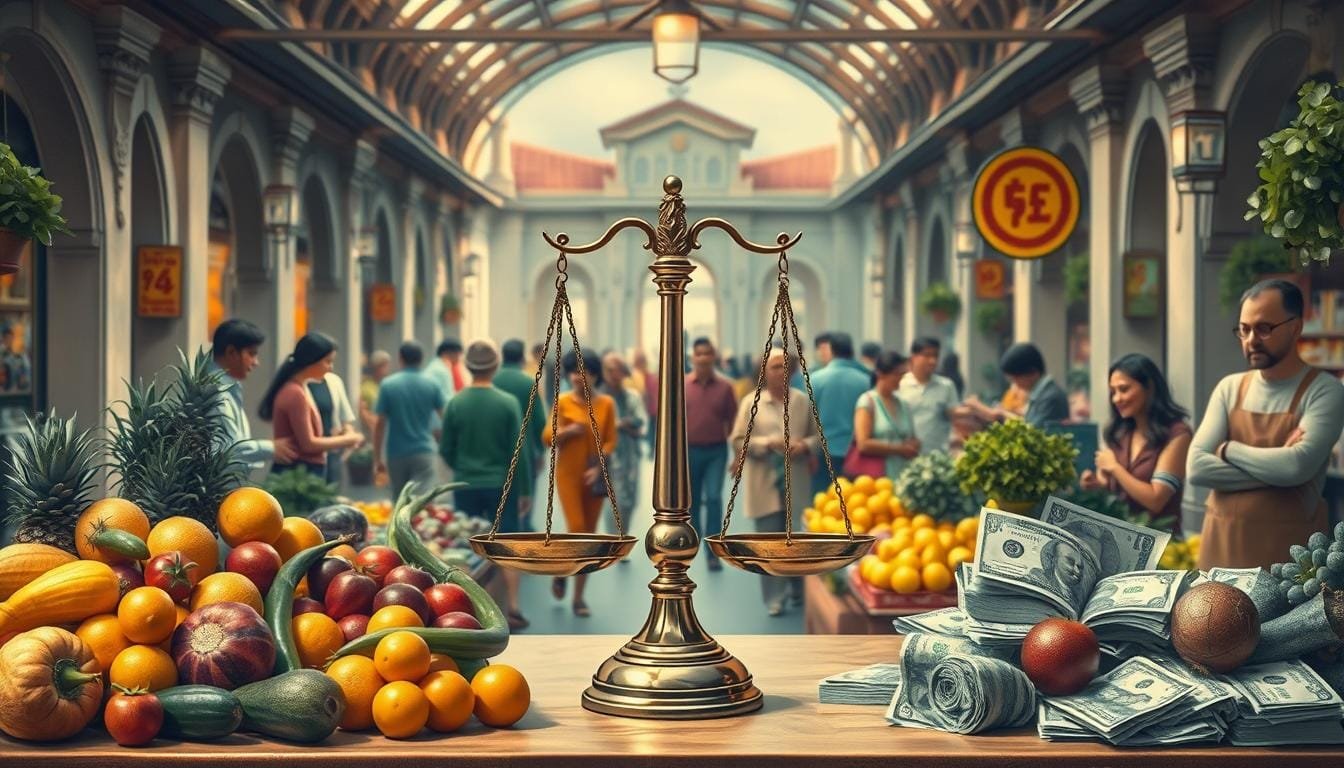Have you ever thought about why a 2-liter soda bottle stays around $2.50 in different stores? Or why the cost of things like gasoline impacts not just you but the whole economy? These questions come from economic equilibrium. It’s when supply and demand balance perfectly.
Our world changes with new consumer likes, tech upgrades, and unexpected events. Understanding economic balance might seem hard. Everything from our car’s gasoline to our toothpaste is affected. For example, gasoline prices might jump between $1.00 and $2.20. But, the balance point, or equilibrium price, is actually at $1.40 a gallon. This is where supply and demand both meet at 600 million gallons.
Economic equilibrium finds the ideal point where economic factors even out. This ensures goods and services move smoothly, without excess or shortage. Whether looking at economics in detail or broadly, knowing about market balance sheds light on complex economic systems.
Let’s take a closer look at economic equilibrium. We will see how supply, demand, and market forces interact in the real world.
Key Takeaways
- Economic equilibrium occurs at the intersection of supply and demand.
- At equilibrium, consumer and producer surpluses are maximized.
- External factors can cause shifts in supply and demand, leading to temporary disequilibrium.
- The equilibrium price of gasoline is $1.40 per gallon where quantity demanded equals quantity supplied.
- Understanding equilibrium aids in grasping the dynamics of market balance and economic stability.
What is Economic Equilibrium?
Economic equilibrium is a key idea. It’s where the forces of supply and demand meet perfectly. This state makes sure that economic values stay the same over time. We’ll look into this for both small and big economic pictures.
Definition and Key Concepts
Economic equilibrium means supply equals demand. This perfect match is known as the market clearing price. At this point, there’s no extra or missing goods, showing a perfect market balance.
In a competitive equilibrium, supply and demand reach the same point. Here, no one can better their position by changing strategies. Equilibrium has three main traits:
- P1: Agents act consistently.
- P2: No one wants to change their action.
- P3: Equilibrium comes from stability over time.
Market Balance and External Influences
Outside forces can upset market balance. If prices fall below equilibrium, demand exceeds supply, causing shortages. If prices are too high, supply overshoots demand, leading to surpluses. The Nash equilibrium shows firms affecting each other’s outcomes and market prices in competitive situations.
Examples in Microeconomics and Macroeconomics
Economic equilibrium shows up differently across micro and macro levels. In a monopoly, balance is where costs meet revenue, yet this might not match the ideal demand-supply scenario. On a broader scale, equilibrium doesn’t always mean societal well-being. For example, food might be plenty but too pricey, causing hunger.
For a real-life scenario, consider how soda companies priced a 2-liter bottle at about $2.50 in June 2022. This price points to an equilibrium in a highly competitive market, benefiting both buyers and sellers.
| Scenario | Effects on Equilibrium |
|---|---|
| Leftward shift in the demand curve | Decrease in demand, lower market-clearing price, and quantity |
| Rightward shift in the demand curve | Increase in demand, higher market-clearing price, and quantity |
| Leftward shift in the supply curve | Decrease in supply, higher price, lower quantity |
| Rightward shift in the supply curve | Increase in supply, lower price, higher quantity |
Mechanisms Driving Economic Equilibrium
To grasp how economic equilibrium works, we need to look at key elements that keep markets stable. These include how supply meets demand, how prices act as signals, and how entrepreneurs play a part in finding balance.
Role of Supply and Demand
The rules of supply and demand greatly affect market situations. When prices go up, people want less, and when they drop, people want more. At the same time, suppliers react to price changes by adjusting what they offer. This dance between supply and demand sets the stage for finding the right price and quantity for any market.
Take the gasoline market as an example:
| Price of Gasoline (Per Gallon) | Quantity Demanded (Million Gallons) | Quantity Supplied (Million Gallons) |
|---|---|---|
| $1.00 | 800 | 500 |
| $1.20 | 700 | 550 |
| $1.40 (Equilibrium) | 600 | 600 |
| $1.60 | 550 | 640 |
| $1.80 | 500 | 680 |
| $2.00 | 460 | 700 |
| $2.20 | 420 | 720 |
Price Adjustments and Market Signals
Prices tell us a lot about how markets adjust. For instance, a rise in gas prices from $1.00 to $1.40 signals two things. First, customers might buy less gas, dropping demand from 800 million to 600 million gallons. Secondly, this price hike encourages more production, matching supply with demand.
Entrepreneurial Influence on Equilibrium
Entrepreneurs are vital in keeping markets in equilibrium. They use price signals to make smart choices, adjusting to supply and demand. By innovating, they can help stabilize or shake up the market. Their decisions are key to responding to market changes and keeping things balanced.
By understanding supply and demand, how prices guide us, and the role of entrepreneurship, we get the full picture of economic equilibrium. These elements together ensure markets work well and efficiently.
What is Equilibrium in Economics?
Understanding equilibrium is key in knowing how markets work. Equilibrium is when supply and demand balance out. This happens at the point where supply and demand curves meet. This point shows the price and quantity that match what’s supplied and wanted.
Equilibrium Price and Quantity
The idea of equilibrium price shows where supply equals demand. Take the gasoline market as an example. At $1.40 per gallon, both demanded and supplied are 600 million gallons. This shows a perfect market balance, with no excess or shortage.
| Price per Gallon ($) | Quantity Demanded (Million Gallons) | Quantity Supplied (Million Gallons) |
|---|---|---|
| 1.00 | 800 | 500 |
| 1.20 | 700 | 550 |
| 1.40 (Equilibrium) | 600 | 600 |
| 1.80 | 500 | 680 |
| 2.00 | 460 | 720 |
Reaching Market Equilibrium
Market equilibrium comes from pricing and production adjustments. Prices change, like in the gasoline market. When the price goes from $1.00 to $2.00, demand drops from 800 to 460 million gallons. This shows how demand decreases when prices go up.
Supply, on the other hand, increases from 500 million to 720 million gallons. This happens over the same price change. It shows how supply grows with higher prices. If the price is too high or too low, it can cause too much supply or too much demand. For example, at $1.80, we see too much supply: 680 million supplied versus 500 million wanted.

Getting to equilibrium in economics is a moving process. It’s driven by market signals and adjustments. It seeks a balance that changes with the market.
Types of Economic Equilibrium
Learning about economic equilibrium is key to understanding market stability. It helps us see how markets react to changes. By looking at each market and the whole economy, we get insights into how economies work.
Partial vs. General Equilibrium
There are two main concepts in economic equilibrium: partial equilibrium and general equilibrium. Partial equilibrium looks at one market by itself. It sees how supply and demand interact in that market alone. For example, examining the housing market would involve checking how prices and homes’ quantities are affected. On the other hand, general equilibrium looks at all markets together. It considers how different economic sectors connect and influence each other.

Competitive Equilibrium
In a competitive market, competitive equilibrium is key. It happens when prices are set freely, based on supply and demand. No single buyer or seller can control the prices. This ensures that resources are used well. It’s all about sellers trying to be cost-effective and buyers looking for the best offers.
Intertemporal Equilibrium
Intertemporal equilibrium is about understanding market changes over time. It thinks about now and the future. This approach helps us see how expectations affect current markets. By knowing this, we can better understand economic stability through time.
Disequilibrium: When Markets Fall Out of Balance
Market disequilibrium happens when sudden changes like economic shocks or new policies upset the balance. These changes can lead to instability. This happens through too much or too little product in the market. Knowing how these shifts work is essential for good economic forecasts.

A surplus is when there is more product available than people want to buy. In contrast, a shortage happens when there’s not enough product for everyone who wants to buy it. This usually means prices will change.
In early 2020, the oil market saw big disruptions. A price war and the Covid-19 pandemic made oil prices drop a lot. On April 20, 2020, the cost to store oil was more than the oil’s value. This caused oil prices to go negative for the first time.
Setting a minimum wage too high can also create problems. It can lead to too many people looking for work and not enough jobs. Another example is the May 6, 2010, Flash Crash. A big sell order by one trader caused the Dow Jones to fall almost 9% very quickly.
“The market lost over one trillion dollars in equity, recovering approximately 70% by the end of the trading day,” according to the U.S. SEC.
The following table shows how these imbalances can play out:
| Market Condition | Quantity Supplied (Q2) | Quantity Demanded (Q1) | Impact |
|---|---|---|---|
| Surplus | Exceeds | Does not meet | Temporary Imbalance |
| Shortage | Does not meet | Exceeds | Increased Prices |
| Equilibrium | Equals | Equals | Stable Prices |
Understanding market shifts is crucial for spotting disruptions and creating good policies. Different economic theories like Keynesian or Laissez-faire offer ways to fix these imbalances. The goal is always to balance supply and demand well.
Conclusion
Economic equilibrium shows the balance in markets. It helps us understand how markets work at their core. For example, when gas costs $1.40 per gallon and the demand matches supply at 600 million gallons, we see this balance.
There are various kinds of economic balance, like the Walrasian and the Nash Equilibrium. They show different ways that markets can be stable. The New Keynesian model shows how prices adjust in the short term. This is different from long-term models where supply and demand balance out more strongly.
These models give us a basic framework, but real life is often more complicated. Knowing that equilibrium is an ideal, not always real, helps us understand markets better. We learn the importance of entrepreneurs, market signals, and outside forces. This summary of economic equilibrium teaches us that markets need constant watching and adjusting. By keeping this in mind, we can better understand and navigate economic trends.
FAQ
What is economic equilibrium in simple terms?
Economic equilibrium happens when supply and demand are equal. This leads to both the amount of goods people want and the amount available being the same, creating a stable market.
How is market equilibrium identified?
You find market equilibrium where the supply and demand curves meet. This point shows the market’s balance in price and quantity, where what consumers want equals what producers offer.
What role do supply and demand play in achieving economic equilibrium?
Supply and demand are key to finding economic balance. Changes in them affect prices and how much is available. This prompts adjustments, balancing the market forces.
Can you give an example of economic equilibrium in real life?
Sure, consider a popular smartphone market. Economic balance is reached when the number of smartphones people want to buy at a price matches what producers are willing to sell.
What are some external factors that can disturb market equilibrium?
Economic shocks, policy changes, or new consumer tastes can disrupt balance. This might lead to too much supply or demand.
How do entrepreneurs influence economic equilibrium?
Entrepreneurs help reach economic balance by making choices based on market trends. Their actions adjust supply to match demand, moving the market towards balance.
What is the difference between partial and general equilibrium?
Partial equilibrium looks at one market alone. General equilibrium checks how all markets connect and balance at the same time.
How does competitive equilibrium relate to economic equilibrium?
In a competitive market, no one can control prices alone. This lets supply and demand freely set the market balance for price and amount.
What is intertemporal equilibrium?
Intertemporal equilibrium studies prices and quantities over time. It considers future expectations alongside today’s market conditions.
What causes disequilibrium in markets?
Disequilibrium happens when external forces upset market balance, leading to too much or not enough supply. This can be due to sudden economic events, changes in what people want, or policy updates.
Why is understanding economic equilibrium important?
Knowing about economic balance helps predict market trends, plan policies, and make smart business choices. It reveals how markets seek balance and the challenges in keeping it.
Is market equilibrium a permanent state?
No, market balance is an idea more than a constant reality. Markets change with economic conditions, making equilibrium a moving target in active economies.
